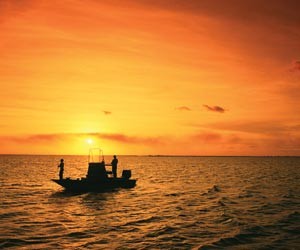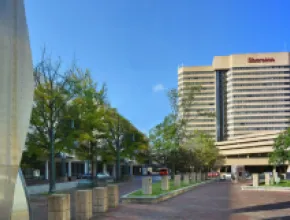As Southwest Airlines’ catchy tag- line puts it, "Wanna get away?" South Texas may be the answer for groups for various reasons. It boasts tropical breezes, ecotourism options, a cultural mix of languages and cuisines, sunny days most of the year and plenty of interesting meeting venues. The region is located near major airport hubs Dallas/Fort Worth and Houston, and has airports of its own in locales such as Corpus Christi and Harlingen, making it easy to get away from it all without getting away from it all.
Corpus Christi
Corpus Christi is loved by groups for its tried and true experiences along 100 miles of beaches.
"It’s all about being outdoors and enjoying nature," says Kevin Arnold, CEO of the Corpus Christi CVB. "Our destination has always been known as a great place to enjoy the outdoors, but there’s an increased interest in nature experiences."
Arnold says groups are enjoying fishing excursions, kayaking and playing golf. Newport Dunes, a new golf course that recently debuted in Port Aransas, about 40 minutes from downtown Corpus Christi, offers views of Corpus Christi Bay and the Gulf of Mexico.
A new cruise option that recently debuted is the Texas State Aquarium Explorer, a 100-foot luxury yacht that leaves from the aquarium.
The aquarium itself is an excellent option for gatherings, Arnold points out. The entire aquarium can host groups of 3,000 to 5,000 non-seated and 300 to 500 seated. Its Dolphin Bay Underwater Room accommodates between 125 for a seated affair and 200 for receptions.
Another popular off-site venue is the historic USS Lexington aircraft carrier. In addition to hosting private functions, the World War II aircraft carrier/museum includes new virtual battle stations. The ship also features a combat flight simulator.
Another group option is the Art Museum of South Texas, with its impressive 2006 addition designed by Mexico City architect Ricardo Legorreta. The complex’s Miller and Johnson buildings can each host up to 350.
"It’s got probably the most unique views of Corpus Christi Bay," Arnold says.
The main meeting venue here is the American Bank Center, which offers a 76,500-square-foot exhibit hall, the 10,500-seat American Bank Center Arena and 22 breakout rooms. It also includes the 20,000-square-foot Bayview Ballroom.
"The lobby outside the ballroom is a great prefunction space for up to 1,000 people," Arnold says.
On the hotel front, Arnold says the Omni Corpus Christi Bayfront Tower is undergoing a renovation that is expected to be completed by spring 2011.
Corpus Christi offers 8,000 hotel rooms, 3,500 of which are located no more than 15 minutes from the convention center.
Laredo
Laredo has the distinction of flying seven flags, including the flag of the Republic of the Rio Grande, along with the Six Flags of Texas. The 250-year-old city offers a lot of history for groups, along with great weather, affordability and hotel choices ranging from budget options to upscale properties.
"The city was established in 1755, so there are a lot of unique historic sites and venues," says Blasita J. Lopez, director of the Laredo CVB. "Our history really sets us apart from other cities in the state."
Laredo is gaining traction in the meetings industry. This summer it is hosting a religious conference of 9,000 to 10,000 attendees. Laredo will host the Texas Association of CVBs in 2012.
"We are also doing well with sports groups," Lopez notes.
Major meeting sites include the multipurpose Laredo Energy Arena (formerly known as the Laredo Entertainment Center), which has 10,000 seats, and the Laredo Civic Center, with a nearly 2,000-seat auditorium and a 24,500-square-foot banquet and exhibit hall.
More than 800 rooms have been added to the hotel inventory in the last five years. Laredo offers a total of about 4,000 rooms. Courtyard Laredo recently underwent a redesign, and LaQuinta Inn is currently undergoing improvements to rooms and public spaces.
During down time, attendees can check out Mall del Norte or browse for Mexican imports along San Bernardo Avenue. As with much of South Texas, visitors will find a number of birding sites.
McAllen
McAllen, situated about 70 miles west of South Padre Island, bills itself as both the population center of the Rio Grande Valley and "The Texas Tropics." There are plenty of nature tours, nightlife, shopping and golf.
The region’s Santa Ana National Wildlife Refuge is an important site in the birding world, and planners can coordinate events there. Another top spot for a naturalistic agenda is Quintana Mazatlan, the McAllen Wing of the World Birding Center, which offers meandering trails to spy birds and an adobe hacienda for events.
McAllen is one of the country’s fastest-growing cities. Nightlife options are evolving thanks to the new 17th Street Entertainment District. McAllen’s Art District is home to more than two dozen galleries and the recently completed Art Village, a 30,000-square-foot space that houses art studios, galleries, creative firms and restaurants.
The main meeting option is the McAllen Convention Center, which was built in 2007 and offers 61,500 square feet of exhibit space and 25,725 square feet of meeting rooms.
Private event venues on the water include Riverside Club and Pepe’s on the River.
Harlingen
Harlingen, the third-largest city in the Rio Grande Valley, is named after the city of Harlingen, Netherlands. Attendees are sure to notice the many colors of the city, both in the forms of fanciful birds and colorful murals depicting Aztec legends throughout the city. Harlingen boasts a central location, so groups are never too far from other cities in the valley, the beach and Mexico.
Visitors interested in history can tour the Marine Military Academy and Jackson Street, with its Art Deco and Mid-Century Modern architecture. Taylor Street was once known as Silk Stocking Row, where some of the wealthiest people in the region built homes in the 1930s.
Main event options here include Harlingen Auditorium and the Regional Academic Health Center.
South Padre Island
South Padre Island’s vast stretches of undeveloped beaches and natural wildlife preserves attract 1 million visitors per year. The 34-mile-long barrier island is about one-half mile at its widest point. The city itself is contained in four and a half miles.
"We don’t own shoehorns," says Dan Quandt, executive director for the South Padre Island CVB. "We don’t try to squeeze in large numbers of attendees to the point where they are uncomfortable."
And South Padre Island is all about loosening up and being comfortable. In 1997, the island passed a proclamation against wearing ties. First offenders are let off easy with a written notice and a complimentary South Padre Island T-shirt, and second offenders are fined the cost of a silk tie.
Quandt says the island ideally accommodates groups of up to 500, but recently hosted a 2,000-person trade show.
The relaxed vibe doesn’t mean that South Padre Island isn’t serious about meetings. The South Padre Convention Centre offers 45,000 square feet of event space. Major meetings properties include the Sheraton South Padre Island Beach Hotel & Condominiums and Isla Grand Beach Resort.
Relaxing on the beach, water skiing, surfing and horseback riding are just some of the activities that appeal to groups. Ecotourism is popular, with dolphin boat trips, sea turtle viewing and birding. The Dolphin and Nature Research Center provides interactive encounters with the Gulf’s creatures and stresses the importance of conservation. The small island has recorded more than 306 bird species.
Located across from the city and over the Queen Isabella Memorial Bridge, the quaint fishing village of Port Isabel is also worth exploration. Along with idyllic beaches, attendees can check out the Point Isabel Lighthouse, with views of the Gulf and Laguna Madre Bay. Tours are available from the island to the Mexican town of Matamoros, situated just 30 miles away.
One popular team-building option that is gaining ground, or maybe more specifically, sand, is team sand castle building.
"This goes beyond the bucket," Quandt says. "A group can bring in a master sculptor to show them how to build a masterpiece."
Other popular group activities include fishing, golf tournaments and spa experiences.
Brownsville
Brownsville, situated at the southernmost tip of Texas, records at least 234 sun-filled days annually. In addition to warm coastal breezes, the area offers golf, excursions to nearby Mexico and plenty of unique history.
"There are six golf courses within 15 minutes of town," notes Mariano "Bean" Ayala, president and CEO of the Brownsville CVB. "And we have wonderful attractions that are also historic."
Most of the city’s historic treasures are located in the Mitte Cultural District. An anchor of the district, the Historic Brownsville Museum was built in 1928 and is an impressive example of Spanish Colonial revival architecture. One featured exhibit is a wood-burning locomotive, the last one of its kind in the world.
"One of our most unique museums is the Costumes of the Americas Museum," Ayala notes. "It includes a collection of more than 400 native dress outfits from most of the countries in the Western Hemisphere. We always get feedback on how interesting and colorful the museum is."
The district also includes the Brownsville Museum of Fine Art, a children’s museum and the Old City Cemetery Center. The Ringgold Civic Pavilion, located in the Dean Porter Park, can host up to 350. The Gladys Porter Zoo is another good off-site pick and is not your garden variety zoo. It features three generations of gorillas, komodo dragons and plenty of additional fauna and flora. A number of native wild birds call the zoo home from time to time.
The new Brownsville Sports Park has kicked the local economy into gear. A number of sports teams from outside the area are drawn to the variety and scale of the park, which includes 10 lighted sports fields.
"There are walking and biking trails, a huge skate park and two party pavilions," Ayala says. "It’s helping us to capture more of the sports market."






